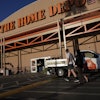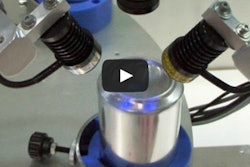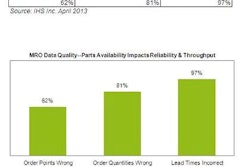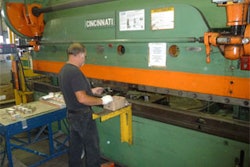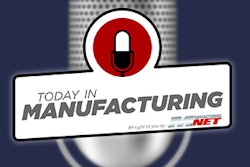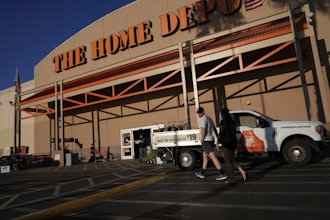Manufacturers face new resources as they look to improve the agility, profitability, and visibility of their facility’s assets.
This article first appeared in IMPO's July 2013 issue.
Asset management, at its core, is all about profitability. If a manufacturer can gain a clear picture of how and where assets are being used, they can account for overuse, underuse, lost items, bottlenecks, theft, and more.
And in doing so, there is an endless list of tools to consider. It’s important to remember that not all assets are as in-your-face as a 10,000 pound forklift – and that the effects of losing track of a smaller item – a hand tool, for example – can be catastrophic. Snap-on takes asset management seriously when developing its products, and believes that all hand tools can be controlled and managed with a comprehensive tool control program.
“Losing tools on a job is the biggest risk of improper management of tool assets,” explains John Ficcadenti, Snap-on Industrial product manager, hand tools. Interestingly, it’s often not the cost of the lost tool itself that should have manufactures concerned.
“A tool left behind in a machine or piece of equipment can severely damage that system, leading to costly downtime and repairs,” Ficcadenti says. Foreign Object Damage (FOD), a term coined in the aviation industry, relates to the resulting damage that comes from an article being left behind after maintenance. Since these are oftentimes tools, manufacturers like Snap-on have taken their experience in the aviation industry and used it to help apply safeguards to their tools for use in manufacturing maintenance.
One way they have accomplished this has been through the development of toolboxes designed with tool control in mind. Says Ficcadenti, “A common scenario is for a technician to leave a tool behind on a jobsite, and not realize the tool is missing. Tools should have a specific location in a toolbox.” Snap-on’s solution has been to add foam cutouts in each drawer. Foam cutouts provide a home for each tool, and visually show a technician if a tool is missing following a job.
Another component of a good tool control program is security. “All boxes should be locked to prevent tool loss. Features like keyless entry can be programmed to open a box with an ID tag or push button combination as keys frequently can be lost.” In addition, explains Ficcadenti, newer advances in tool control include digital imaging technology in which cameras photograph tool box drawers at the time of the tool issue, and return to visually show and record any missing tools. Voice-activated functions alert a technician of all transactions to further monitor and manage tool use.
Michael Fein, Zebra Technologies senior product manager, RFID, explains how misconceptions around RFID might create big missed opportunities for manufacturers. One misconception is that RFID is too complicated to implement and is still an “experimental” technology. The reality is that the current generation of RFID technology has gone through several product design cycles and is reliable, interoperable, and scalable. Systems integrators experienced in RFID are streamlining RFID installations, making it more simple than ever to implement RFID solutions within a facility. Another misconception is that RFID is too expensive and that ROI is elusive. The reality is that end-users across many verticals are achieving double-digit ROI through improved asset visibility as the cost to manufacturer RFID tags has decreased significantly, making them more attainable. Leading companies in retail, manufacturing, transportation, healthcare, etc. are separating themselves from competition and improving customer satisfaction with RFID. Finally, there is a misconception that RFID doesn’t work on metal, liquid, or other non-traditional surfaces. However, there is now a tag appropriate for virtually any item – whether it’s a label on a cardboard box, a personnel badge, a durable tag for a re-usable metal shipping rack, or anything in between. |
The Mobility Factor
Tool control isn’t the only asset management technology that is becoming more sophisticated. Bentley Systems offers comprehensive software solutions for the infrastructure lifecycle, and asset performance is a key area of focus. Its new mobile app, APM Supervisor’s Dashboard, was launched at Bentley’s Ivara user conference in early May, with the intention of addressing user feedback as it relates to mobility.
“Maintenance supervisors want and need to know their assets are safe and in good operating order,” explains Sandra DiMatteo, director of marketing, asset performance for Bentley Systems. “We’ve now provided them with the ability to monitor their site or plant or asset status while they’re working away from the plant. So this way they’ll know the condition of their equipment at a moment’s notice – and specifically which assets are in an alarm state. If necessary, they can even approve the work to be done right there on the spot.”
According to DiMatteo, one of the key user benefits of the app is that it allows maintenance professionals to focus more on preventive measures, therefore the emergency issues can now be fewer and further between. With an asset performance management system, users are collecting data proactively and are able to take action before the equipment actually fails. “Then you’re not going to get that emergency call at 4am.” It’s these benefits, combined with the consumer trends that drive business requirements to have access to data 24-7, which have caused a stir among manufacturers. “It is definitely exponentially more important to them in the last couple of years,” she says. “They’re asking for more and more functionality. We’ve tried to respond with shorter development cycles in order to keep up with their pace and their desire to go more mobile.”
Real-Time Locating
From Zebra Technology's perspective, asset management is all about information – and the more up-to-date the better. This is why the company specializes in solutions that are highly scalable, and run the gambit from simple first steps like barcoding to more complex technology like active RFID and real time locating systems (RTLS). According to Adebayo Onigbanjo, senior product marketing manager, location solutions for Zebra, even smaller manufacturers can start with a few elements of a RTLS and grow the investment as they experience the ROI or a need for greater visibility. “For example,” says Onigbanjo, “a manufacturer may want to start by implementing ultra-wideband tags on a few selected, highly valuable items as opposed to tagging the entire facility.”
And besides tracking valuable assets, Zebra sees work in process (WIP) as another critical area to use for asset management resources. “Whether you’re assembling or repairing, using multiple auto identification technologies, including barcode, active and passive RFID can help manufacturers monitor WIP and streamline operations by increasing visibility across the facility,” says Onigbanjo. For instance, by capturing and analyzing cycle and dwell times throughout an operation, manufacturers can develop insights into both upstream and downstream constraints and make adjustments where needed. “Some examples of WIP technology applications include industrial tool tracking,” he says. “A manufacturer can keep costs down and assembly lines moving with a tool management system that gives full visibility of tool assets in real time.”
This relates back to Snap-on’s goal of helping users understand the value of knowing where tools are at any given time. “A technician can waste a lot of time hunting through a disorganized tool box looking for a tool that may not be there,” says Snap-on’s Ficcadenti. “The more time it takes looking for tools means the less time he or she has to complete a job.”
Conclusion
According to Onigbanjo, “An asset management program can be as complex or as simple as a manufacturer needs it to be.” The important point here is that a manufacturer can feel free to start small. For many, they are improving upon a paper system that is prone to errors, missing information, and outdated data.
“(The data) needs to be timely and it needs to be trustworthy,” adds Bentley’s DiMatteo. “You have the data immediately there onsite, so maintenance professionals are not jotting things down on the side of their work order or on their hands; these problems don’t need to fall through the cracks because a note was missed or somebody washed their hands.”



